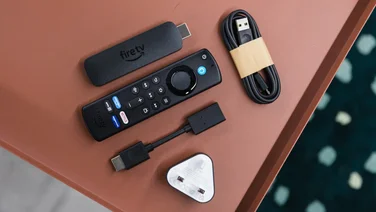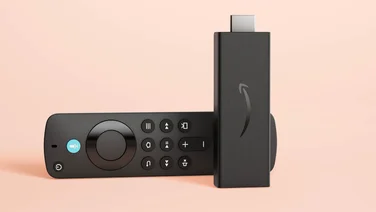To help us provide you with free impartial advice, we may earn a commission if you buy through links on our site. Learn more
- Amazon Fire TV Stick 4K Max review: What you need to know
- Amazon Fire TV Stick 4K Max review: Price and competition
- Amazon Fire TV Stick 4K Max review: Design and setup
- Amazon Fire TV Stick 4K Max review: Fire TV interface
- Amazon Fire TV Stick 4K Max review: Content and performance
- Amazon Fire TV Stick 4K Max review: Verdict











- Wi-Fi 6 compatible
- Alexa voice remote
- Complete HDR support
- Requires mains power
Craving the latest and greatest in 4K streaming? These days, you’re spoiled for choice. Roku, Google and Apple all have amazing UHD HDR-capable streaming sticks (or boxes), and heading into the latter portion of 2021 it seemed as though there was no more room at the figurative 4K inn. That was until Amazon announced an upgrade to its now ancient (in tech terms) Fire TV Stick 4K streamer.
The Fire TV Stick 4K Max is, Amazon says, its most powerful streaming stick ever, promising incredibly fluid UHD streaming thanks to its new Wi-Fi 6 capabilities. At just £55, it looks like a reasonably priced package, too. Read on to find out if it’s worth your time and money, or if it’s purely the preserve of the next-gen Wi-Fi 6 elite.
Amazon Fire TV Stick 4K Max review: What you need to know
The Fire TV Stick 4K Max is the long-awaited update to the original Fire TV Stick 4K, which was first released all the way back in 2018. Other Amazon Fire TV devices have appeared in the time since, including the new Fire TV Stick Lite, but the e-commerce giant has held off on a revamped UHD model until now. So, what’s different about the 4K Max?











Well, this is Amazon’s first streamer with Wi-Fi 6 support, a feature that aims to ensure smoother streaming on 4K content across multiple Wi-Fi 6 devices. You’ll need a compatible Wi-Fi 6 router to enjoy the benefits, of course – and to help me write this review, Amazon provided one of its own Eero 6 dual-band mesh Wi-Fi 6 systems. What’s more, the Fire TV Stick 4K Max can now show live picture-in-picture camera feeds, a feat that previously could only be performed by Amazon’s Fire TV Cube, which was twice the price.
As you’d expect, the 4K Max packs all of the streaming features that made the original 4K model so good. Complete High Dynamic Range support (Dolby Vision, HDR10, HDR10+ and HLG), Dolby Atmos and Dolby Digital Plus are all on board as well, and the Alexa voice remote is as handy as ever.
Amazon Fire TV Stick 4K Max review: Price and competition
Coming in at £55, the Fire TV Stick 4K Max is only marginally more expensive than its predecessor, the £50 Fire TV Stick 4K, which is still the same price, despite launching in 2018. Out of those two, it makes more sense to buy the Max, since it’s more future-proofed and comes with a better remote to boot. Not bothered about 4K, but still want Fire TV and Alexa at your command? The standard Fire TV Stick is a bargain at £40.
The 4K Max is up against some tough non-Amazon competition, too. First up, there’s the Roku Streaming Stick Plus, which while it lacks both Dolby Vision and Wi-Fi 6, remains a fantastic UHD streaming stick with one of the most intuitive streaming platforms in existence, Roku OS. It’s simply a joy to use and, happily, the price has fallen to just £45 since the time of our review.
Alternatively, you could pick up the Chromecast with Google TV for £60. It’s 4K-capable, has solid HDR support (including Dolby Vision) and – for the first time on a Chromecast – has its own remote and UI. It lacked a couple of crucial apps at the time of launch, namely Apple TV Plus and Now, but the former has since been added to the roster.
READ NEXT: The best streaming sticks you can buy
Amazon Fire TV Stick 4K Max review: Design and setup
Let’s face it: if you’ve seen one Fire TV Stick, you’ve seen them all. The dongle itself is yet another piece of black rectangular plastic, descended from a long line of pieces of rectangular plastic. The HDMI ARC output is at one end, and Amazon recommends that you connect that to one of your TV’s HDMI inputs via the bundled HDMI extender in order to improve Wi-Fi and remote performance. To power it, you have to connect the supplied USB cable, located between the mains power adapter and the dongle’s micro-USB port.











The remote is pretty standard Fire TV fare but it is nonetheless a small improvement on the original Stick 4K’s controls. This time around, the black microphone button has been replaced by a pretty blue Alexa key, and below the UI and TV controls you’ll find shortcut buttons for Prime Video, Netflix, Disney Plus and Amazon Music.











Setting up the device on your TV is easy enough, provided you already have an Amazon account – and who doesn’t these days? You simply join your Wi-Fi network (as mentioned, it supports up to 802.11ax, or Wi-Fi 6), sign in to your Amazon account either manually or through your phone and then, after a few minutes of software updates, you’re in.
From the home page, you can launch right into content or start adding apps and adjusting settings as you please. For the purposes of this review, I also took the additional step of installing the Eero 6 Wi-Fi 6 router in order to boost my home’s network.
Amazon Fire TV Stick 4K Max review: Fire TV interface
The Fire TV Stick 4K Max has a slick, user-friendly interface that will feel very familiar to anyone who has used a Fire TV stick previously. Currently running on Fire OS 7.2.5.5, the interface is easy to navigate and quick to respond. It’s a pleasure to use, whether you’re browsing menus, searching for a specific show or installing an app. The screen’s top row has three main sections to jump between – Home, Find, and Live – plus a selection of your go-to apps and access to the settings.
The Home page is split up into rows that feature recommended shows, films and apps in the form of tiles. It’s a similar approach to Android TV, though I think I slightly prefer Android’s system, mainly due to Fire TV’s excessive promotion of all things Amazon. Indeed, Amazon-made content is so heavily featured on the home page that you sometimes forget you’re not in the actual Prime Video app but rather in the main menu. However, among the glut of Amazon shows, it does offer up a few rows of third-party content.











The next section, Find, is your portal to the app store as well as your personal library of saved content. From here, you can also select content categories in order to search in a more targeted way, as opposed to listlessly browsing the endless rows on the home page. But, if you already know what you want, using the Alexa voice search button is by far the most efficient way to find it. Lastly, the Live menu shows you where to watch content that’s being broadcast right now.











READ NEXT: The best smart TV platforms
Amazon Fire TV Stick 4K Max review: Content and performance
The Fire TV’s menu of apps is as varied as you’ll find on any other streaming OS. From the main menu, you can jump into any popular paid service of your choosing, from Netflix and Now to Disney Plus and Apple TV. In terms of free content, you get all the usual UK catch-up apps plus the likes of YouTube and IMDb TV.
Watching the latest 4K HDR content through the Max was as enjoyable as I expected it to be. Dolby Vision film The Green Knight looked phenomenally gritty, full of foreboding shadow but never so dark as to obscure the embroidered finery and weatherbeaten faces of Aruthurian legend. Meanwhile, select scenes from the HDR10+ show Good Omens offered explosions of light and colour, with details as crisp as can be.
But then again, these shows looked no better or worse than they did when viewed through the Prime Video app installed on my LG CX TV. As always, when it comes to streaming sticks, the quality of the playback largely depends on the calibre of the TV and broadband. To get the most from the Fire TV Stick 4K Max, you’ll want a decent 4K TV that supports HDR10, HDR10+, HLG and Dolby Vision.
I should point out that I watched the same 4K HDR content twice on the Stick 4K Max, both with the Eero Pro 6 enabled and with it disconnected. There were no differences as far as I could discern, but then again my Vodafone Wi-Fi hub is in the same room as my TV, so connectivity has never been an issue for me when streaming in 4K HDR. If your device is further away, or you have a number of devices streaming content simultaneously across the household, you might stand to benefit more from the Wi-Fi 6 boost.
READ NEXT: The best 4K HDR TVs you can buy
Amazon Fire TV Stick 4K Max review: Verdict
Unless you already have a Fire TV Stick 4K, the Fire TV Stick 4K Max is the logical purchase if you’re after a future-proofed 4K HDR streamer. It’s only a fiver more than its predecessor yet packs in a number of new features, the most significant being the inclusion of Wi-Fi 6 support.











And since it offers Dolby Atmos, has the full range of HDR formats, and doesn’t lack any of the major streaming services, it’s the most complete 4K streaming stick you can buy for £60 or less. As a matter of fact, it’s arguably the best streamer you can buy short of shelling out for an Amazon Fire TV Cube or an Apple TV 4K, both of which cost over £100.
| Amazon Fire TV Stick 4K Max specifications | |
|---|---|
| Supported resolution | Up to 3840 x 2160 (4K) at 60fps |
| HDR | Dolby Vision, HDR10, HDR10+, HLG |
| Audio support | Dolby Digital Plus, Dolby Atmos |
| Apps | Amazon Prime Video, Netflix, Disney Plus, Now, BBC iPlayer, ITV Hub, All 4, My5, UKTV Play, IMDb TV, Eurosport etc. |
| Connectivity | 802.11 a/b/g/n/ac/ax (Wi-Fi 6) |
| Ports | HDMI ARC output, micro-USB (power only) |
| Voice assistants | Amazon Alexa |
| OS | Fire OS 7.2.5.5 |









